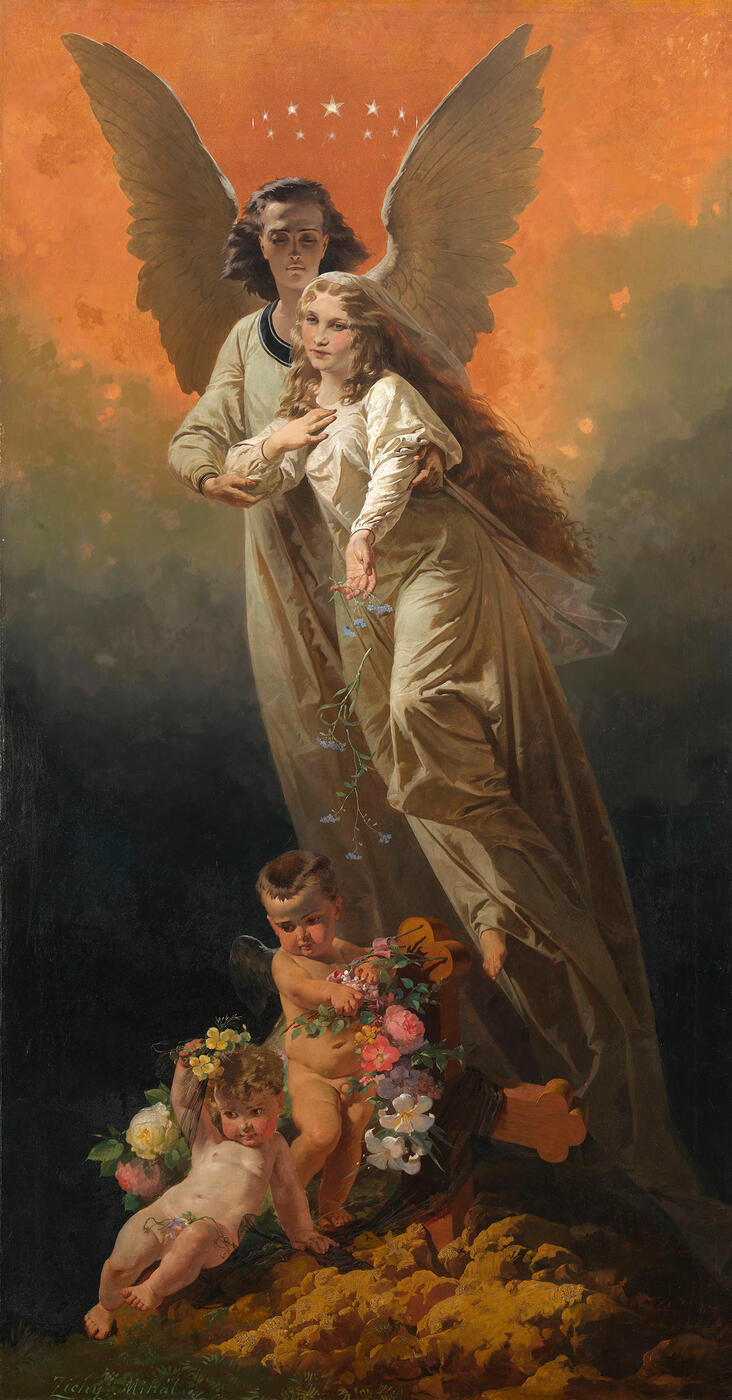27 Nov 2013 Russian Art Auctions
27 November 2013

15. ZICHY, MIKHAIL (1827-1906)
Allegorical Composition, signed and dated 1863.
Oil on canvas, 210 by 110 cm.
320,000–500,000 GBP
Provenance: Collection of the Eperjessys, the maternal side of the artist’s family, Hungary.
A gift from the above to the previous owner in 1959.
Thence by descent.
Acquired from the above by the present owner.
Private collection, Europe.
Authenticity of the work has been confirmed by the expert V. Petrov.
Authenticity certificate from the art historian and legal expert on 19th and 20th century Hungarian art, Dr Gábor Bellák.
Literature: B. Lázár, Zichy Mihaly elete es műveszete, Budapest, Athenaeum, 1927, pl. 3, illustrated, incorrectly dated 1847.
I. Berkovits, Zichy Mihaly elete es munkassaga, Budapest, Akadémiai Kiadó, 1964, pp. 62 and 361, mentioned in the text and listed.
Allegorical Composition is one of Mikhail Zichy’s rare large-scale works. The artist was famous for chronicling the life of the Russian court in watercolour illustrations through the reigns of four emperors, from Nikolai I to Nikolai II, and for his humorous and erotic drawings. Rarely, however, did he turn to painting canvasses, and only when prompted to from the depths of his soul.
Originally Hungarian, Zichy spent practically all his artistic career attached to the Russian court. Over these years he only rarely forsook Russia and his duties to surrender to the creative freedom he found far away at the Zala estate in his native land, and in Vienna, Budapest and Paris. Most likely it was during one of these trips in 1863 that the work offered here was created.
The late 1850s and early 1860s see the artist first preoccupied with Gothic themes and allegories. His interest is in the romanticised theme of death, the fate of fallen angels cast out by God, and the role of the Genius of Death in man’s destiny. At the same time, and partly under the influence of Gustave Doré who addresses himself in turn to illustrations of Dante’s Divine Comedy, Milton’s Paradise Lost and the Apocalypse, Zichy creates compositions inspired by the poetry of Lermontov and biblical motifs. This is very clearly evident in his monumental Allegorical Composition. The artist would even confess that “from the time I came to appreciate Russian ways, the work of Lermontov gave rise to the real reverence that I feel for this poet”.
Lermontov’s poem The Angel (In his arms he carried an infant soul,/ Bound for a world of sorrow and tears;/ And within the young soul the sound of his song/ Remained, without words, but alive) was extraordinarily popular in the mid 19th century and Zichy undoubtedly knew it, as he did the traditional Christian iconography of a messenger sent to awaken man from his sleep and bring him the gift of life and salvation. “Awake, fair soul, from the sleep and inebriation into which thou hast sunk. (...) Follow me to those exalted places that were thy original abode”: thus begins the fragment of the Gnostic myth preserved by St Hippolytus of Rome.
The pale blue blossom trailing from the Virgin’s hand is a reference to the artist’s romantic ideals. Nurtured by the German Romantics, pre-eminently Novalis, the emblem of the blue flower had become the symbol of a poetic dream, of romantic ennui and a yearning, in the final analysis, for Heaven to make its way down to Earth. Thus, Zichy’s use in the painting of Novalis’ blue flower lends further symbolic overtones to the allegory. Painted in a tranquil, academic manner, Allegorical Composition may be placed, both in terms of its size and scale of conception, among Zichy’s most important compositions, religious or secular.
Despite Zichy’s considerable artistic legacy held in the Hermitage, the Tsars’ residences in the environs of St Petersburg, and the museums of Moscow and Georgia, only a few paintings by Zichy have been preserved, and the present lot is one of these rarities.
The subject of Allegorical Composition must have been created by Mikhail Zichy for private commission. The work is signed in Hungarian and is dated 1863 which leads us to the conclusion that it was executed by the artist during a brief sojourn in Hungary that year. The painting was in the possession of the Eperjessy family for almost a hundred years, from 1863 until 1959, when Sándor Eperjessy gave it to a friend, as documented in the family archives.
The Eperjessy family provenance is of great importance as Zichy’s mother’s maiden name was Eperjessy, meaning the painting comes from the innermost family circle of the artist.
The first known publication of Allegorical Composition is in Béla Lázár’s monograph of 1927, where it is reproduced with the incorrect date of 1847. Here, Eperjessy is named as the owner of the picture. In 1964, when Ilona Berkovits published the first academic monograph on the artist, it was catalogued as belonging to a private collection.
Allegorical Composition is, unquestionably, a work of the finest quality and with very strong provenance. More importantly, the painting has hitherto never been exhibited, thus its appearance on the market may be considered a veritable sensation.
We are grateful to Gabor Bellak, art historian and legal expert on 19th and 20th century Hungarian art, for providing catalogue information.
Notes on symbols:
* Indicates 5% Import Duty Charge applies.
Ω Indicates 20% Import Duty Charge applies.
§ Indicates Artist's Resale Right applies.
† Indicates Standard VAT scheme applies, and the rate of 20% VAT will be charged on both hammer price and premium.